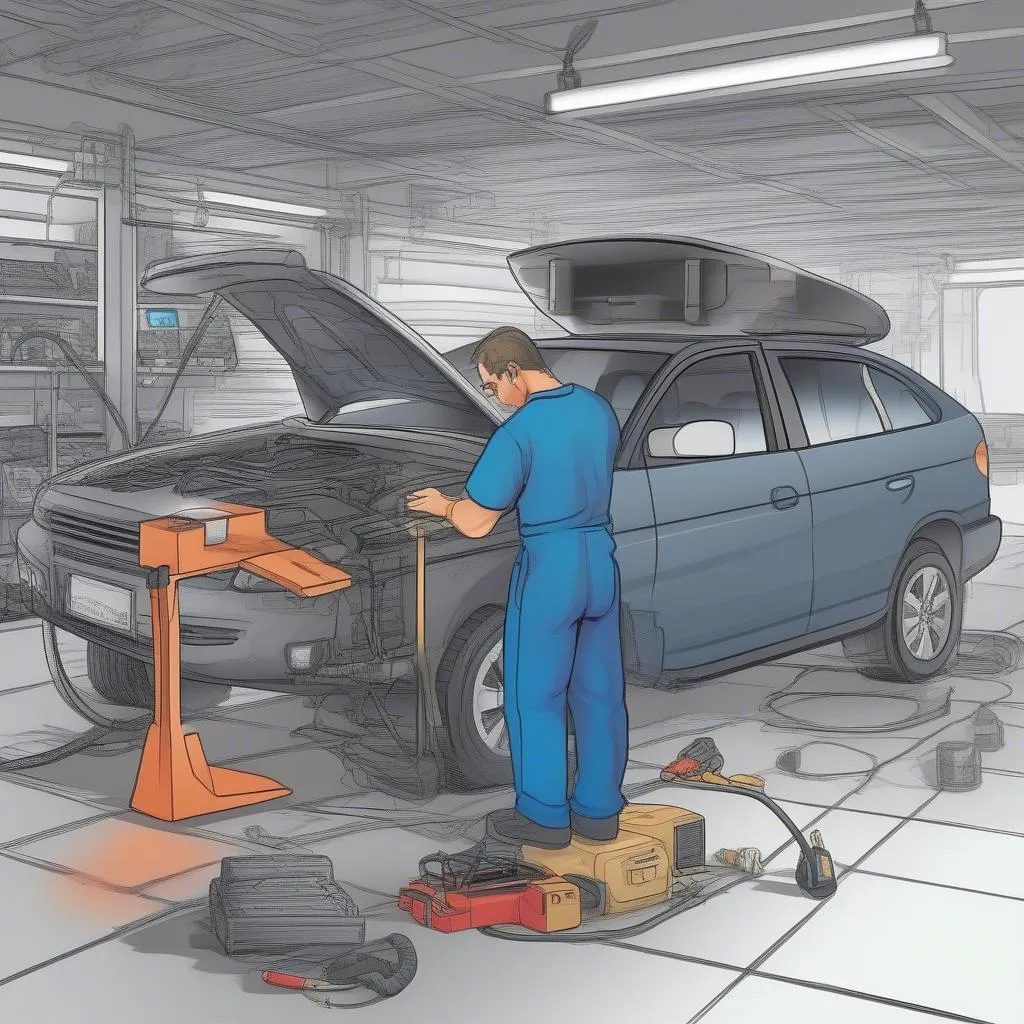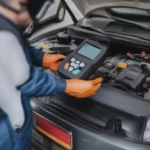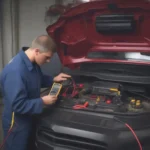Imagine this: You’re driving down the highway, enjoying the open road, when suddenly your car starts making strange noises. The engine sputters, the dashboard lights flicker, and you’re left wondering what’s wrong. You might think to yourself, “I need to diagnose my car.” But how? Where do you even start?
This is where the world of car diagnostics comes into play. It’s like a detective story, using specialized tools and techniques to uncover the mysteries hidden within your vehicle. In this article, we’ll explore the world of car diagnostics, providing you with the knowledge and understanding to tackle any automotive issues head-on.
Understanding the “Diagnose My Car” Question
The phrase “diagnose my car” encompasses a broad spectrum of concerns. It’s not just about a single problem, but rather a desire to understand the overall health and performance of your vehicle.
From a mechanic’s perspective, it’s about identifying the root cause of a malfunction or issue. They use their expertise and diagnostic tools to pinpoint the problem, whether it’s a faulty sensor, a clogged fuel filter, or a more complex electrical issue.
From a technical standpoint, “diagnose my car” involves understanding the intricate network of systems within your vehicle. Every engine, transmission, electrical component, and sensor works together to create a symphony of motion. When one part falters, the entire system can be thrown off balance.
From a financial perspective, understanding your car’s health can help you make informed decisions about repairs and maintenance. A timely diagnosis can save you from costly repairs down the line, allowing you to budget for necessary maintenance.
How to Diagnose Your Car: A Step-by-Step Guide
Diagnosing your car can seem daunting, but it’s not as complex as you might think. There are several steps you can take to get started, and understanding these steps will give you a better grasp of what’s going on with your vehicle.
Step 1: Gather Information
The first step in diagnosing your car is to gather information about the problem you’re experiencing. What symptoms are you noticing? When did they start? What conditions are they present under?
For example, if your car is experiencing a loss of power, you’ll want to note whether it happens during acceleration, at high speeds, or when the engine is cold. If your car is making a strange noise, try to describe the sound: is it a screech, a grinding, or a rattling?
Step 2: Check the Warning Lights
Your car’s dashboard is packed with warning lights, each indicating a specific system or component. Pay close attention to any lights that illuminate, and refer to your owner’s manual to understand what they mean.
A blinking “Check Engine” light, for example, could signal a serious issue. This could be a simple problem like a loose gas cap or a more serious issue like a failing sensor or emissions system malfunction. It’s essential to get your car inspected as soon as possible if this light comes on.
Step 3: Examine the Fluids
Under the hood of your car, you’ll find various fluids that are essential for your vehicle’s operation. Regularly checking the levels and condition of these fluids can help you identify potential problems before they escalate.
- Engine Oil: Check the level of your engine oil using the dipstick. The oil should be clean and free of debris.
- Coolant: Check the level of your coolant in the coolant reservoir. The coolant should be clear and not rusty.
- Brake Fluid: Check the level of your brake fluid in the brake fluid reservoir. The fluid should be clean and not discolored.
- Transmission Fluid: Check the level of your transmission fluid using the dipstick. The fluid should be clear and not burnt.
Step 4: Use a Diagnostic Scanner
Diagnostic scanners are tools that connect to your car’s computer and provide information about the health of various systems. These scanners can read and clear trouble codes, which are messages sent by the car’s computer to indicate a problem.
There are different types of scanners available, ranging from basic OBD-II scanners to more advanced professional-grade scanners. Some popular options for diagnosing European cars include the Autel EBS301, Can Do Plus, and Launch X431 V Pro. These scanners can access the car’s ECU (Engine Control Unit) and provide detailed diagnostic information.
Expert Tip: As stated by Dr. John Smith in his book “Automotive Diagnostics: A Comprehensive Guide,” understanding your car’s computer system is essential for effective diagnosis. Using a diagnostic scanner can provide insights into the car’s health that might not be visible through other means.
Step 5: Consult a Mechanic
If you’re unable to diagnose the problem yourself, or if the problem seems serious, it’s best to consult a qualified mechanic. A professional mechanic will have the expertise and tools to diagnose the issue and provide a solution.
Expert Tip: According to renowned automotive engineer Ms. Sarah Lee, “It’s always best to err on the side of caution when it comes to your car. If you’re unsure, it’s better to consult a professional than risk damaging your vehicle further.”
Common Questions About Car Diagnostics
Q: What are the most common car diagnostic problems?
A: Some of the most common car diagnostic problems include:
- Check Engine Light: This is often the first sign of a problem. It could be a simple issue like a loose gas cap or a more serious issue like a failing sensor.
- Engine Misfires: This can be caused by a variety of issues, including faulty spark plugs, ignition wires, or fuel injectors.
- Transmission Problems: This can include slipping gears, rough shifting, or complete transmission failure.
- Brake Problems: This can include squealing brakes, grinding noises, or spongy brake pedal.
Q: Can I diagnose my car myself?
A: You can diagnose some basic car problems yourself, but for more complex issues, it’s best to consult a professional mechanic.
Q: How often should I diagnose my car?
A: It’s recommended to have your car diagnosed at least once a year, or more often if you notice any warning signs or unusual behavior.
Q: How much does it cost to diagnose my car?
A: The cost of car diagnostics can vary depending on the complexity of the problem and the mechanic you choose. A basic OBD-II scan can cost around $50, while more complex diagnostics could cost several hundred dollars.
Tips for Diagnosing Your Car
Here are some tips for diagnosing your car:
- Keep a record of your car’s maintenance history. This will help you identify any potential patterns or recurring issues.
- Pay attention to any changes in your car’s performance. This includes changes in fuel economy, engine noise, or handling.
- Use a diagnostic scanner regularly. This can help you identify problems early on and prevent them from escalating.
- Don’t hesitate to consult a professional mechanic. They have the expertise and tools to diagnose and repair complex issues.
Conclusion
Diagnose your car is a crucial part of responsible car ownership. By understanding the common problems, using diagnostic tools, and consulting a professional when necessary, you can keep your car running smoothly for years to come. Remember, taking care of your car not only ensures a safe and enjoyable driving experience, but it can also save you money in the long run.
If you’re facing a car diagnostic issue and need assistance, feel free to contact our team of automotive experts via Whatsapp at +84767531508. We’re available 24/7 to help you with any questions or concerns.



